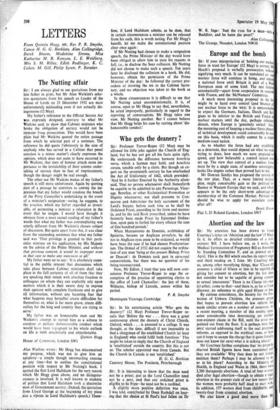Abortion and the law
Sir: My attention has been drawn to Louis Courtney's letter on 'Abortion and the law' (5 May). In it, he offers us detailed criticisms of a non- existent Bill. I have before me, as 1 write, the Medical Termination of Pregnancy Bill as Amended by Standing Committee F, and as printed on 5 April. This is the Bill which reaches its report stage and third reading on 2 June. Mr Courtney tells us, among other mystifying things, that 'Clause (dl assumes a child of fifteen or less to be capable of giving her consent to abortion, but the law does not consider her to be capable of giving consent to sexual intercourse.' There is no Clause (d)--not (c) either, come to that—and there is, as far as I Can discover, no reference to girls aged fifteen or less.
By curious coincidence, the Society for the Pro- tection of Unborn Children, the pressure group that hopes to prevent abortion law reform, has made similar errors on a number of occasions. At a recent meeting, a member of this society spent some considerable time denouncing yet another non-existent clause in the Bill, until the error was pointed out from the floor. It is perhaps time that SPUC started addressing itself to the real proposed reforms, as opposed to the mythical ones, or bow can it hope to escape the charge that it quite literally does not know (or care) what it is talking about? Mr Courtney further complains that 'no properly charted British figures have been mentioned and they are available.' Why then does he not indeed mention them? Perhaps I may be allowed to do so in his place? According to the Ministry of Health, in England and Wales in 1964, there were 3,300 therapeutic abortions. A total of four women died after legal abortion—though to obtain a legal abortion in the present state of our law means that the women were probably half dead to start with. In addition, 177 women died from childbirth; and twenty-four from criminal abortion.
We also know a good deal more than W
Courtney supposes about the social effects of a liberal abortion policy. In Aberdeen, as is well known by now, some 2 per cent of pregnancies have been terminated for some years. As a result, pointed out the Sunday Times recently, 'Aberdeen's back street abortionists now appear to be out of business. In 1962 the chief constable's report for the city included five abortions in the list of crimes against the person. Since then there has been none. Professor MacGillivry says: "The number of septic abortions is so small in Aberdeen that a trial of a new antibiotic drug could not be introduced be- cause there were not enough cases of septicaemia."'



































 Previous page
Previous page